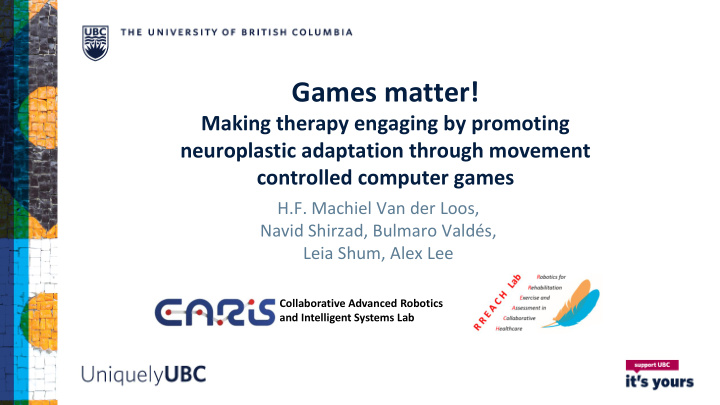



Games matter! Making therapy engaging by promoting neuroplastic adaptation through movement controlled computer games H.F. Machiel Van der Loos, Navid Shirzad, Bulmaro Valdés, Leia Shum, Alex Lee Collaborative Advanced Robotics and Intelligent Systems Lab
What are the costs of f stroke? • Stroke is the most common source of long-term adult disability in North America. 1 • Only 5-20% of people affected regain full upper- extremity functionality. 2 • The “dose” of movements required for recovery is estimated to be in the thousands. 3,4 • But only ~30 repetitions of a movement are practiced in a usual therapy session. 5 1 [AHA Statistics, 2013], 2 [Van Peppen et al. Clin Rehab, 2004] 3 [Sathian et al. NNR, 2011], 4 [Sawaki et al. NNR, 2008], 5 [Lang et al. APMR, 2009]
What are the strengths of f games? • 500 million people have installed Candy Crush TM . (That’s about 8% of the people in the world!) 1 • 58% of Americans play video games. 2 • 45% of gamers are female. 2 • Nearly half of adults over 50 play video games (computers, cellphones, consoles). 2 1 [http://www.bbc.com/news/magazine-25334716] 2 [2013 Demographic and Usage Data, ESA]
How to help solve this big problem? • Large quantities of practice Traditional Therapy Gaming Supplement lead to neuroplastic change and behavioural recovery. 1 Critical volume Volume of movements • Practice needs to be challenging, progressive, and specific to the individual. 2,3 • Can we use games to increase specific movements in the affected limb? Total Per week 1 [Kleim et al. JSLHS, 2008], 2 [Boyd et al. Neuro Letters, 2010], 3 [Taub et al. Stroke, 2013]
Smart controls for engaging therapy Design Testing Programming
The FEATHERS Project Functional Engagement in Assisted Therapy through Exercise Robotics • To develop a new solution for upper-limb rehabilitation in stroke and CP populations • 3 years, funded by UBC PWSI, started in 2012 and continued through KBHN 2013-2018 • 3 UBC Departments (Drs. Van der Loos, Croft, Boyd, Virji- Babul, Hodges), 3 clinics, 1 company, +30 people
User-centred Approach in in Medical Devic ice Desig ign 1. What is the problem that needs to be solved? 2. How can we solve the problem? Inclusion of the user in the design team 3. Is the proposed solution effective? Zenios in BioDesign (2009), Martin in Applied Ergonomics (2012)
Methodology: User-centred Design
Stroke Therapy: Functional Needs Stroke: the most common source of long-term adult disability in North America Repetition of therapeutic exercises is the key to induce neuroplasticity and functional reorganization of the motor cortex Recovery only Back to independent Stroke leads to disability through intensive life therapy news.brown.edu Getty Images Getty Images Van Peppen in Clin Rehab (2004), Schaechter in Prog Neurobiol (2004), Boyd in Stroke (2014)
Stroke Therapy: Context xtual Needs Qualitative research through clinical immersion aimed at: 1. Establishing a multi-faceted understanding of the problem in its context 2. Engaging therapists and therapy clients to co-create technologies User’s Problem: The Paradox of Repetition… User’s Desire: To Play Games and Interact with Friends… Needs Statement: to develop an exercise system that tracks arm movement to play games and connects the users via a social media platform Lohse, JNPT (2013), Lam, JMIR Rehabil (2015), Tatla, JMIR Serious Games (2015)
How does FEATHERS Control Cursor Movement? • Game controllers (PS3 Move, Kinect) for motion tracking • Unimanual exercise vs bimanual exercise Valdes in EMBC (2014)
FEATHERS…
Thank You For more information: Email: vdl@mech.ubc.ca Google Search: UBC FEATHERS Web: http://caris.mech.ubc.ca/feathers/project-summary/ 13 13
Recommend
More recommend